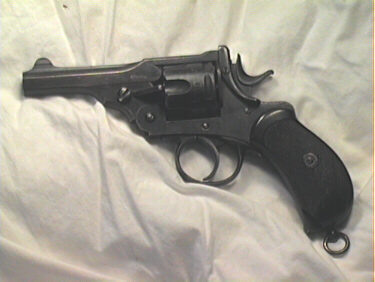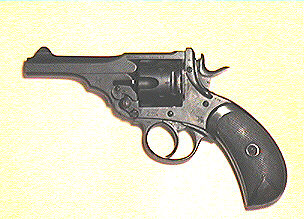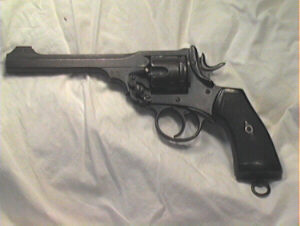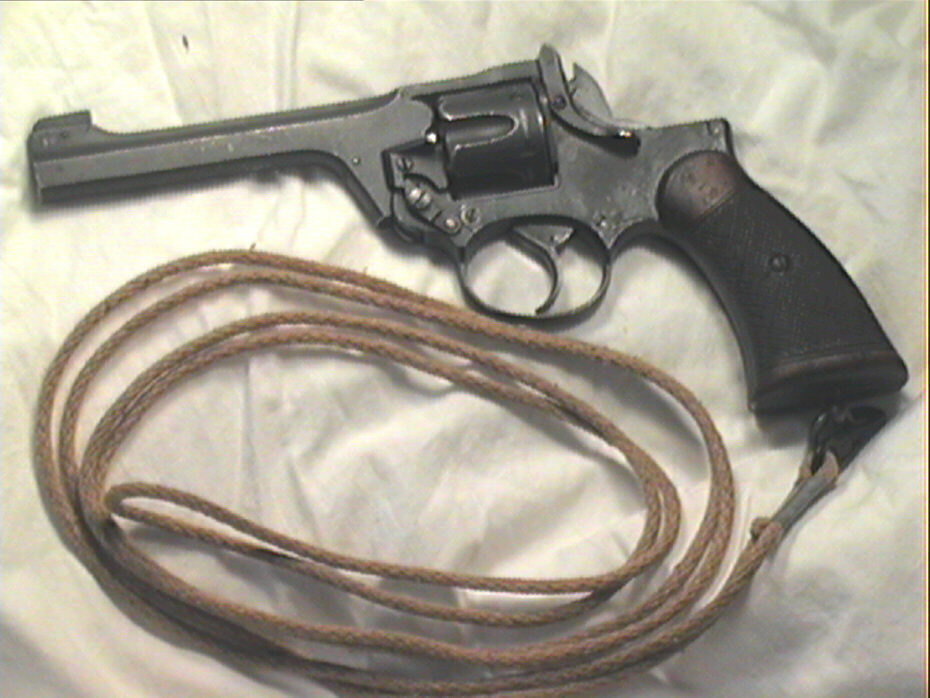 Mark I Webley Revolver
Mark I Webley Revolver
The British Government used Webley revolvers as standard or limited standard for 60 years. The Mark I was adopted in November 1887, and the last of the standard Webley revolvers, the No. 1 Mark VI, was declared obsolete in 1947. All the standard British issue Webley revolvers were caliber.455, and all were similar in design. The Webley is a top breaking revolver locked by a heavy stirrup type barrel catch. The first five have "birds head" type grips, and the Mark VI has a square grip. The Mark VI (called No. 1 Mark VI after 1927), which was adopted in May 1915, was made in the greatest quantity, 300,000 of these revolvers having been made by Webley & Scott at Birmingham during World War I. A quantity of the Mark VI were also made at Enfield Lock after World War I.
Ammunition: Many .455 Webleys have had the cylinders modified in order to accept .45 ACP and .45 Auto-Rim rounds. In the case of the .45 ACP it is necessary to utilize half-moon or full moon clips. The vast majority of Webleys in the United States have been modified in this manner due to the scarcity of the original .455 Webley ammunition in the U.S. The Fiocchi Cartridge Company of Italy has produced the .455 caliber Webley. This still made by found at gun shows, or may be available through specialty shops, such as The Western Scrounger.
Differences in Model Mark I through Mark VI
Mark I Original configuration. 4 inch barrel, pivoting barrel and cylinder unit with self extraction upon breaking open.
 Mark I Webley Revolver
Mark I Webley Revolver
Mark I* Upgraded Mk I to Mk II features. Has hardened steel plate added, dovetailed across the face of shield, secured by fixing screw. Mk II hammer replaces Mk I pattern. Head of grip rounded off, thumbpiece of barrel catch smaller. All parts on Mk I and Mk I* interchangeable.
Mark II Hardened steel plate dovetailed across the face of shield. Heavy cavalry hammer with less pointed nose. New hammer catch spring replaces V-shaped spring. Lever, auxiliary extractor actuated by spiral spring, replacing the spring, extractor lever. Thumbpiece is smaller, grip differently shaped with head entirely removed. Guard is more serviceable shape with corners rounded off.
Mark III Whiting’s Patent modification of cylinder cam, cam lever and fixing screw. Limited production, not issued.
Mark IV Different quality steel used in manufacturing. Cylinder mounted on fixed axis, secured in and forming part of the barrel. Automatic cam hold cylinder at time of extraction. Lightened hammer but same nose shape as on Mark II. New pattern of shield, slots in cylinder for trigger stop are wider, the trigger stop is raised. Ratchet teeth of extractor are case hardened, pawl lifting point hardened.Mark IV Webley
Cylinder mounted on fixed axis, secured in and forming part of the barrel. Automatic cam hold cylinder at time of extraction. Lightened hammer but same nose shape as on Mark II. New pattern of shield, slots in cylinder for trigger stop are wider, the trigger stop is raised. Ratchet teeth of extractor are case hardened, pawl lifting point hardened.Mark IV Webley
Mark V Cylinder diameter increased .012” for nitro powder and a radius is formed on the rear corner. Top of revolver body enlarged to accommodate bigger cylinder.
Mark VI Squared target grip, longer 6 inch barrel with removable foresight. Longer butt swivel, additional stock pin fitted higher up the butt. Barrel catch has axis bosses formed on inside faces.  Plain portion of shank of barrel catch screw is shorter and the threaded portion longer.
Plain portion of shank of barrel catch screw is shorter and the threaded portion longer.
Mark VI Webley Revolver
After World War I, the British decided that .455 was too heavy for the most effective use and after tests decided upon the use of a caliber .38 cartridge based on the .38 Smith & Wesson cartridge case. Webley designed a new pistol using many of the features of their commercial Mark III caliber .38 revolver.
The design was taken over by Royal Small Arms Factory and as completed was not compatible with the Webley pistol; parts are not interchangeable. The Webley Mark IV caliber .38 revolver was adopted as limited standard in World War II.
Similiar to the Webley revolvers are the Enfield revolvers. The .38 No. 2 Mark I Revolver was produced from 1927 to 1938. It was officially adopted on 2 June 1932, manufactured exclusively at R.S.A.F.
| 1-9999 | circa 1929-1931 |
|---|---|
| A1-A9999 | 1932 |
| B1-B9999 | 1932-33 |
| C1-C9999 | 1934 |
| D1-D9999 | 1935 |
| E1-E9999 | 1936 |
| F1-F9999 | 1937 |


.380 Enfield No. 2 Revolver, by Mark Stamps and Ian Skennerton
Small Arms Identification Series .455 Pistol, Revolver No.1 Mark VI, by Ian Skennerton
Any Questions? Please send to:kotto@bright.net